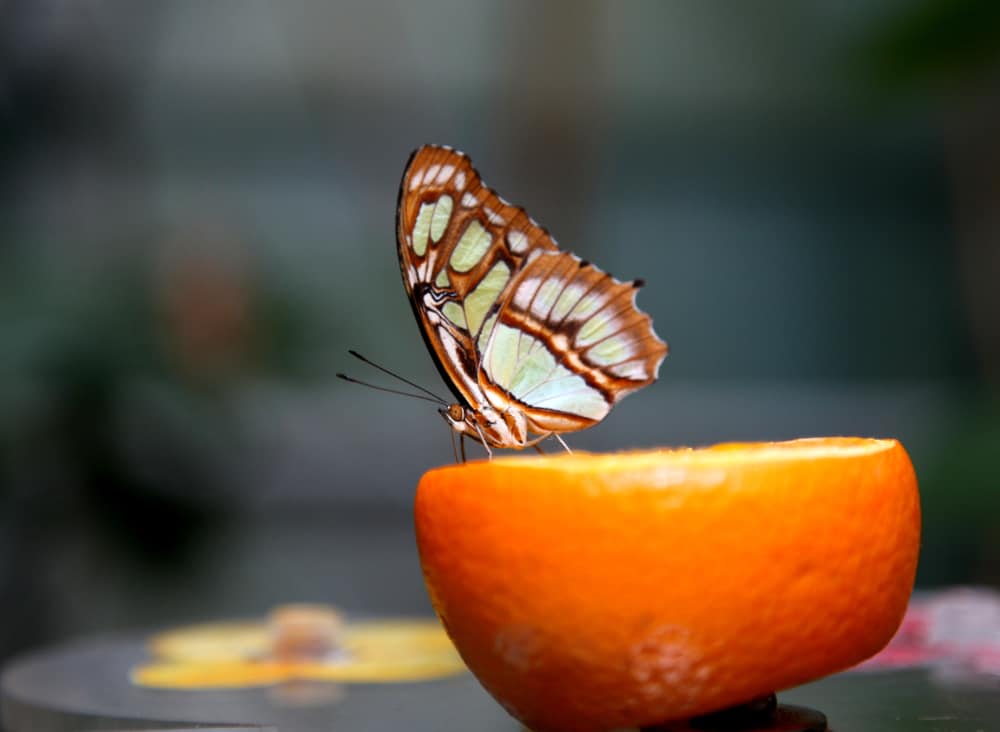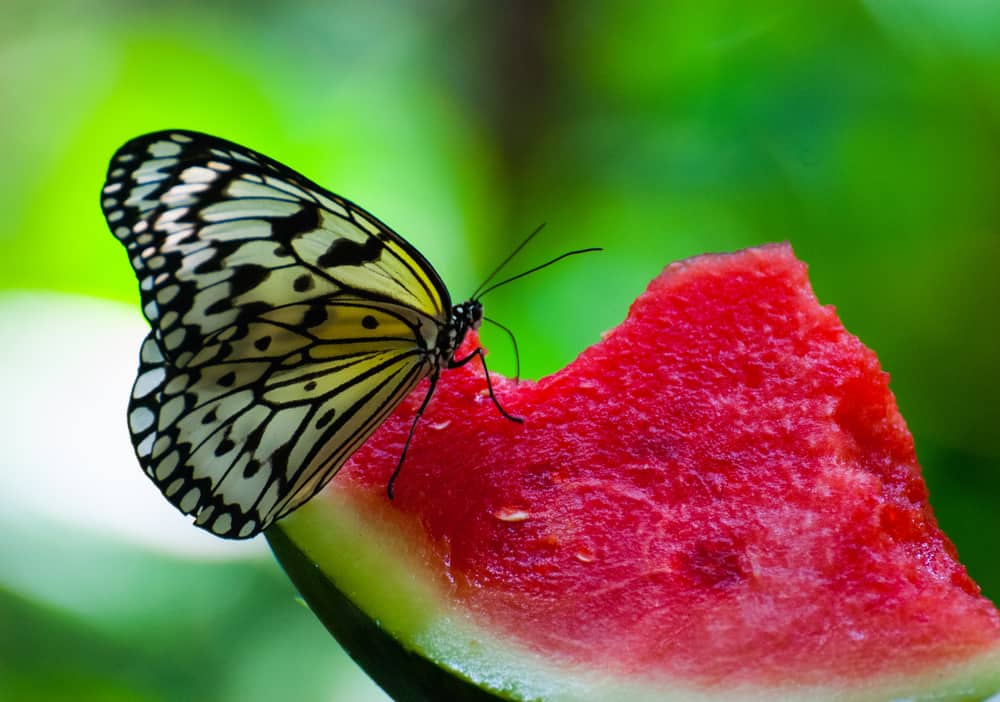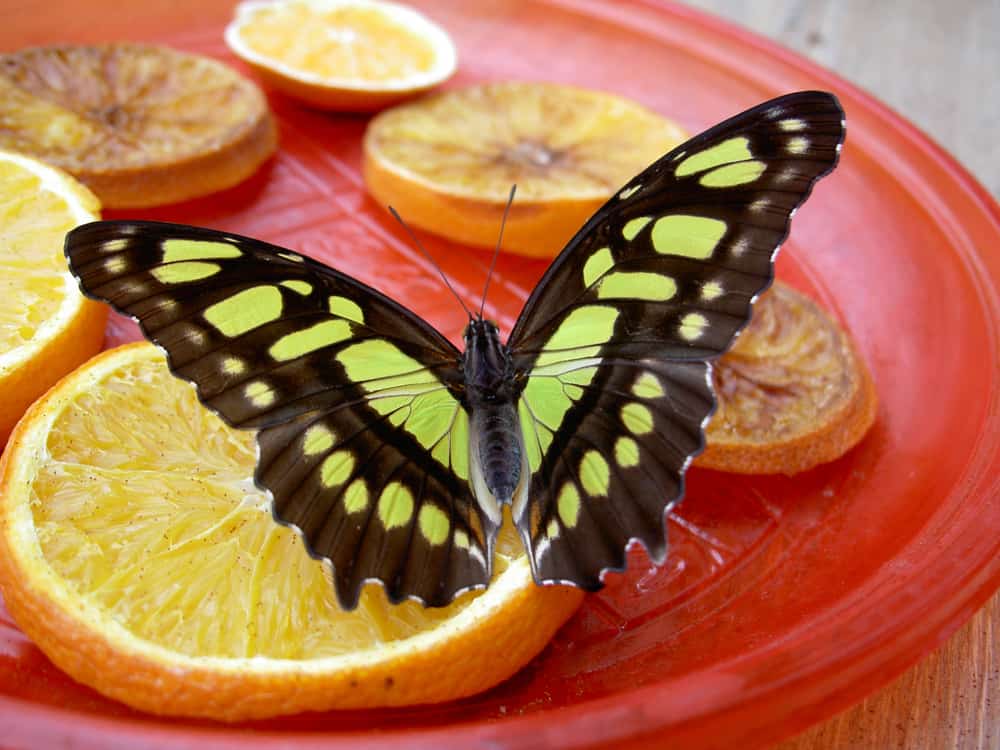Indeed, who doesn’t love watching one of these magical beauties fly? It’s tough to imagine that butterflies are insects. And if so, what do they eat? How do they eat?
You commonly see them gracefully sailing from one flower to another. The mystery behind what butterflies eat most rests within the flower.
butterflies Habits And Biology
Butterflies are insects that undergo complete metamorphosis. Metamorphosis – this is the transformation from an immature form to an adult form in two stages. For this process to be whole, the insect undergoes four stages.
Adult butterflies lay their eggs on the food plant on which larvae (caterpillar) feed for sustenance. Some species of butterfly larvae are labeled as pests as they damage domestic crops and trees.
Magnificent but simple creatures, butterflies, are uniquely designed to adapt to their environment, from their brightly colored wings for flight and camouflage to their distinctive ways of feeding.
In place of their mouths, butterflies have a proboscis. The proboscis has two lobes, like straws, joined together. Due to the proboscis, these four-winged insects survive solely on a liquid diet.
They use their proboscis to sip delightful nectar from flowers. Sometimes nectar lies deep within a flower, and the proboscis enables the butterfly to reach the sugary delight.
Butterflies spend most of their time foraging for food. Are you aware that butterflies taste with their feet? Yes, this is the most uncommon adaptation butterflies possess in relation to their feeding habits.
Their feet have sensors on them that allow them to find food for their young ones. Butterflies land on leaves and taste them to determine where they will lay their eggs. The plant will serve as a food source for their larvae.
Other species of butterfly, particularly the Monarch butterfly, feed on poisonous plants like the milkweed. Predators use these toxins obtained from the plant as a defense mechanism.
Finally, some species of butterflies migrate during winter seasons using the sun as their compass. The American Monarch travel an average of 25,000 miles to escape the cold.
Other species of butterflies hibernate during cold or wintry seasons.
Butterflies are simple creatures, but they exhibit a rare trait that aids in sustaining their good health and survival and that of their offspring, as discussed above.
Do Butterflies Eat Dirt?
Yes. Butterflies do feed on dirt. The practice of dirt feeding is known as ‘mud puddling,’ largely carried out by males.
They assemble around a pool of muddy creek beds or muddy puddles in groups called ‘puddle clubs’ and sip on the nutrient-rich water.
After mud puddling, nutrients obtained from the soil are later passed to the females as nuptial (marriage) gifts during mating.
The female butterflies can assess the males’ ability to provide nutrients from their counterparts’ body odor. In turn, the nutrients aid in reproduction.
What Do Butterflies Eat Most?
Butterflies are classified as herbivores as they depend mainly on plants for food. But what exactly do butterflies eat most? That is the question.
- Nectar –is the primary source of food for butterflies. It is obtained mainly from plants and flowers.
- Nectar is primarily rich in sugars, among other nutrients that butterflies use for energy. Each species of butterfly has a preferred plant where they obtain this sugary delight.
- Tree saps –are rich in salts needed by female butterflies for reproduction.
- For example, the Anise Swallowtail prefers nectar from the lantana, New England aster, columbine plants.
- Old/rotting fruit – also provides a flavorsome meal for these magnificent insects. Amidst autumn months, sugary treats keep them healthy.
- Rotting fruits –such as plums, bananas, apples, and pears are a favorite. They provide enough energy to sustain them throughout the autumn season.
- Mud puddles –provide nutrients that aid in reproduction. The most sort after nutrient from these puddles is mainly sodium and amino acids.
- To obtain the maximum amount of these nutrients, butterflies take in generous amounts of the liquid. They eliminate excess food via the anus.
- Carrion (decaying flesh of dead animals) –is also fed on by butterflies to obtain nutrients. Carrion is rich in ammonium ions, also required during reproduction.
- Cow dung –is rich in ammonium ions as well. Butterflies will also feed on the droppings of other animals, such as bird droppings.
- Urine –is rich in sodium ammonium ions, also crucial in reproduction.
- Secretion of homopterans –homopterans are ‘sucking insects,’ with mouthparts adapted for sucking plants. Some examples include; aphids, whiteflies, and mealybugs.
- Sweat and tears –are yet another good source of nutrients. Butterflies feed on the tears of animals such as turtles and even crocodiles.
- Caterpillars – other butterfly species, primarily the American monarch, feed on their larvae (caterpillars).
- On December 9th, 2019, Yi-Kai Tea, a doctoral student from the University of Sydney School of Life and Environmental Science, observed this phenomenon.
- Yi-Kai-Tea observed Monarch butterflies feeding on milkweed caterpillars. These caterpillars are rich in milkweed as it is their primary source of food after hatching.
- Sugary solutions –placed out by human beings on butterfly feeders, also act as a good source for obtaining the energy required by butterflies.
- A feeder is used to attract butterflies for observation.
- After hibernating, butterflies need to replenish their energy, and these butterfly feeders provide a ready source for food.
- Aphids –are fed on only by one species of butterfly. Did you know the harvester butterfly (Feniseca tarquinius) is the only butterfly known to feed on other insects?
If you thought they only feed on nectar, now you know better. Despite being simple creatures, butterflies have a range of food sources on their menu.
Foods To Avoid Feeding
Lack of teeth is no obstacle for these colorful bugs. They will sip or suck as long as there is food available. The same plants they feed on may prove to be harmful to them.
Therefore, you should avoid feeding butterflies these foods:
- Feeding on plants sprayed with herbicides or pesticides may end up killing butterflies. You must be aware of the plants butterflies eat as those exposed to these chemicals will poison them.
- Ophryocytis Electroscincha, also known as OE –is a single-celled organism called protozoa. It is neither animal nor plant; instead, it shares both characteristics.
- The protozoan only affects the milkweed butterflies. OE requires a host to survive between infections as spores.
- These spores refer to the dominant scales on the Monarch butterfly located on the abdomen. The spores pass down from generation to generation through ingestion of milkweed exposed to infected Monarchs.
- Female monarchs then pass down the spores through the laying of eggs. Caterpillars feed on their eggshells when they hatch—in turn, also feeding on the spores which reproduce in the body.
- These infected Monarchs may either fail to emerge or emerge deformed.
- Black death –is what varied butterfly diseases are known. There are two primary infections likely responsible; bacteria and NPV (Nuclear polyhedrosis virus)
- Bacteria (Pseudomonas) –are found in soils. Plants and soils infected with this bacteria, when ingested, may prove fatal.
- The bacteria cause the caterpillar to be dull, wilt, and have a liquid substance ooze out of either end and turn black. Ultimately, the butterfly larvae die.
- NPV (Nuclear Polyhedrosis Virus) –caterpillars infected with NPV experience the same symptoms as those infected by the Pseudomonas bacteria.
- NPV occurs when one caterpillar feeds on food substances containing the secretions of an infected caterpillar.
Tips To Feeding Butterfly
If you derive pleasure from watching butterflies flutter about gardens and plan on keeping some, you’ll need to know how to care for and feed them. Here are some pointers:
- For butterflies in nature, issue flower nectar. Butterflies survive by ingesting nectar yielded by nature from different flowers.
- Plants in demand among all species of butterflies include; zinnia, lantana, butterfly bush, and the Mexican sunflower. If you want to attract butterflies, plant these in your garden or yard.
- Make a butterfly feeder. A butterfly feeder is used to lure in butterflies for observation or photography.
- You can make a butterfly feeder by setting a flat/shallow plate with a base on your yard or garden. Alternatively, you can also hang a plastic bottle from a tree.
- You may use canned fruit nectar as an alternative food source for flower nectar.
- Pour the fruit into a suitable feeding utensil such as a bottle cap or soak a tissue with the beverage and place it on a butterfly feeder. The feeder can be placed somewhere strategic, like on the porch.
- In the absence of nectar, you can give the butterflies sugar that acts as makeshift nectar.
- Use white caned sugar to issue enough nutrients to the butterflies. White caned sugar dissolves easier in water in comparison to other sugars.
- Rotting fruit can also act as an alternative food source. Slice up fruit that is going bad and place it on your butterfly feeder.
- Add some fruit juice or water to keep the sliced fruit wet/moist.
Looking after and feeding butterflies is not as hard as it may seem. It’s pretty simple as their dietary needs are not complex. Follow these steps, and you’ll have butterflies feeding off your hands in no time.
Summary
Aside from their good looks, butterflies are also well equipped to survive. Their adaptations set them far apart from other insects. These creatures are not ‘just another pretty face.’Now that you know what they eat most and how they eat, don’t judge a book by its cover.


